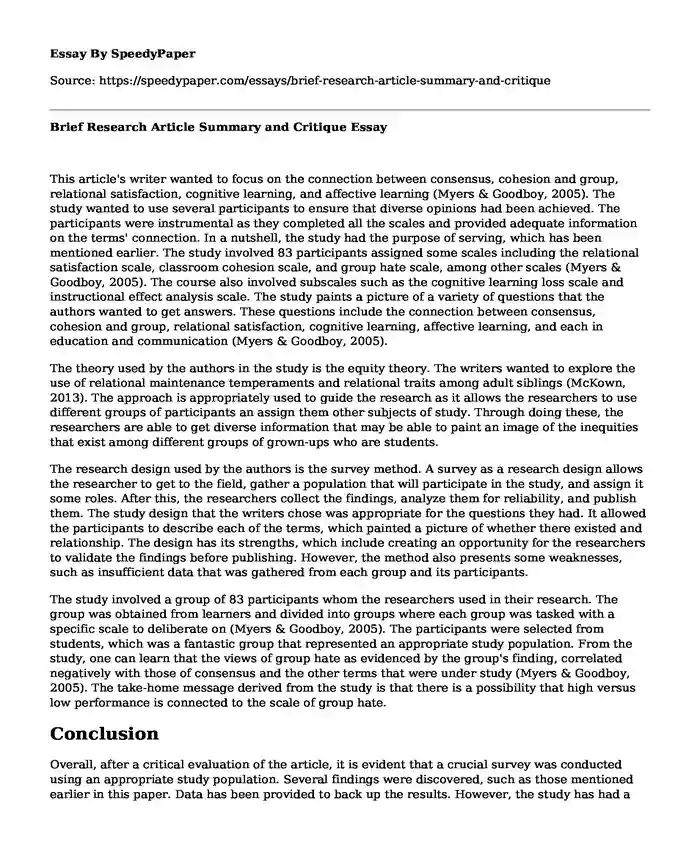
| Type of paper: | Essay |
| Categories: | Learning Education Cognitive development |
| Pages: | 3 |
| Wordcount: | 676 words |
This article's writer wanted to focus on the connection between consensus, cohesion and group, relational satisfaction, cognitive learning, and affective learning (Myers & Goodboy, 2005). The study wanted to use several participants to ensure that diverse opinions had been achieved. The participants were instrumental as they completed all the scales and provided adequate information on the terms' connection. In a nutshell, the study had the purpose of serving, which has been mentioned earlier. The study involved 83 participants assigned some scales including the relational satisfaction scale, classroom cohesion scale, and group hate scale, among other scales (Myers & Goodboy, 2005). The course also involved subscales such as the cognitive learning loss scale and instructional effect analysis scale. The study paints a picture of a variety of questions that the authors wanted to get answers. These questions include the connection between consensus, cohesion and group, relational satisfaction, cognitive learning, affective learning, and each in education and communication (Myers & Goodboy, 2005).
The theory used by the authors in the study is the equity theory. The writers wanted to explore the use of relational maintenance temperaments and relational traits among adult siblings (McKown, 2013). The approach is appropriately used to guide the research as it allows the researchers to use different groups of participants an assign them other subjects of study. Through doing these, the researchers are able to get diverse information that may be able to paint an image of the inequities that exist among different groups of grown-ups who are students.
The research design used by the authors is the survey method. A survey as a research design allows the researcher to get to the field, gather a population that will participate in the study, and assign it some roles. After this, the researchers collect the findings, analyze them for reliability, and publish them. The study design that the writers chose was appropriate for the questions they had. It allowed the participants to describe each of the terms, which painted a picture of whether there existed and relationship. The design has its strengths, which include creating an opportunity for the researchers to validate the findings before publishing. However, the method also presents some weaknesses, such as insufficient data that was gathered from each group and its participants.
The study involved a group of 83 participants whom the researchers used in their research. The group was obtained from learners and divided into groups where each group was tasked with a specific scale to deliberate on (Myers & Goodboy, 2005). The participants were selected from students, which was a fantastic group that represented an appropriate study population. From the study, one can learn that the views of group hate as evidenced by the group's finding, correlated negatively with those of consensus and the other terms that were under study (Myers & Goodboy, 2005). The take-home message derived from the study is that there is a possibility that high versus low performance is connected to the scale of group hate.
Conclusion
Overall, after a critical evaluation of the article, it is evident that a crucial survey was conducted using an appropriate study population. Several findings were discovered, such as those mentioned earlier in this paper. Data has been provided to back up the results. However, the study has had a significant limitation: there is a deficit in terms of the data obtained for each group of participants and its members. Overall, it is a thumbs-up to the authors of the article for providing such critical findings from their research. The authors conducted the study thoroughly which makes it viable and valid for future reference. However, on the part of lack of sufficient data, the authors should have noted but still with the data provided, the research stood out and can therefore be used to provide more information to future researchers of a similar subject.
References
McKown, C. (2013). Social equity theory and racialethnic achievement gaps. Child Development, 84(4), 1120-1136.
Myers, S. A., & Goodboy, A. K. (2005). A Study of Grouphate in a Course on Small Group Communication. Psychological Reports, 97(2), 381–386. https://doi.org/10.2466/pr0.97.2.381-386
Cite this page
Brief Research Article Summary and Critique. (2023, Dec 18). Retrieved from https://speedypaper.com/essays/brief-research-article-summary-and-critique
Request Removal
If you are the original author of this essay and no longer wish to have it published on the SpeedyPaper website, please click below to request its removal:
- Free Essay on Writing Inspiration: Joseph Considered Himself a Writer
- Education Essay Sample on Promoting Learner Autonomy in EAP Courses for Arab Students
- Effects of Social Media on Teenage Kids, Free Essay Example
- Free Essay about Second Language Acquisition by Chinese Learners
- Argumentative Essay Example of Children's Rights
- Free Essay. Attachment Between Adopted Toddler and Adoptive Parents
- Zero Tolerance for School Violence: Unraveling Causes and Advocating for a Safer Learning Environment
Popular categories




